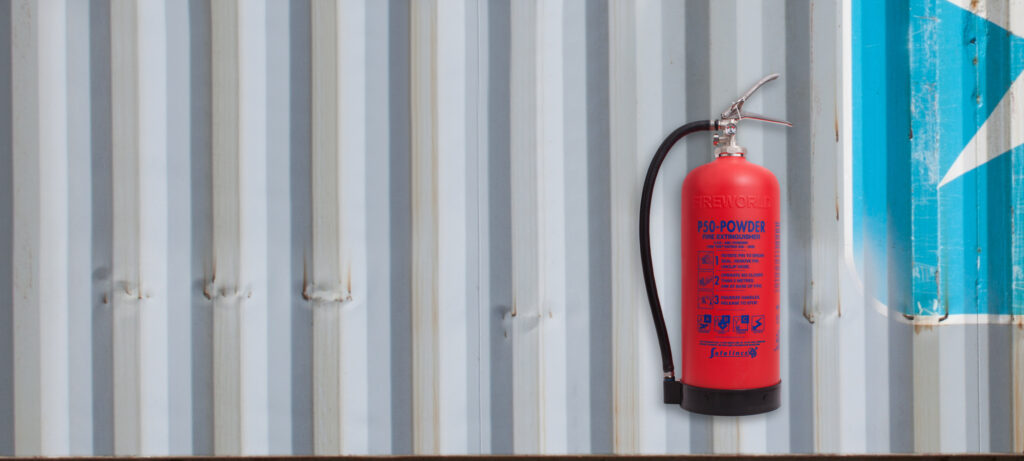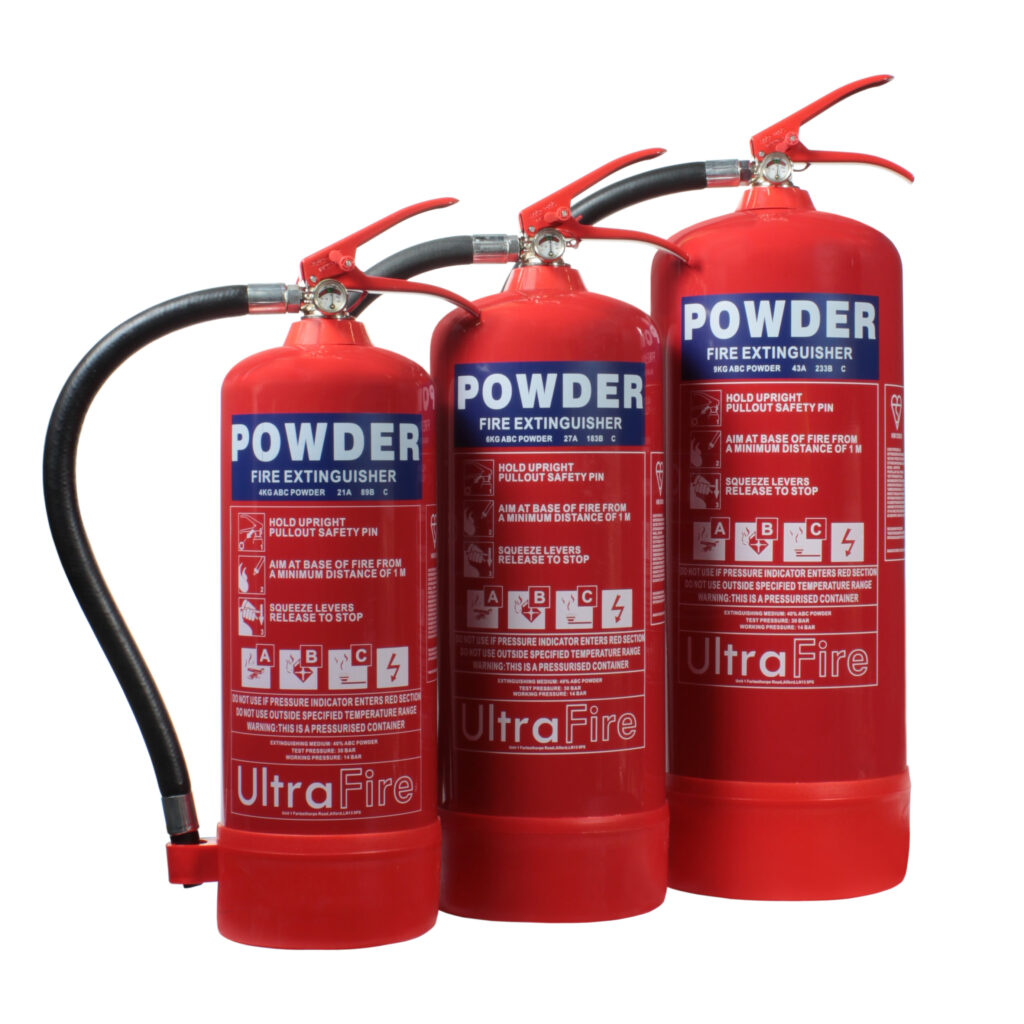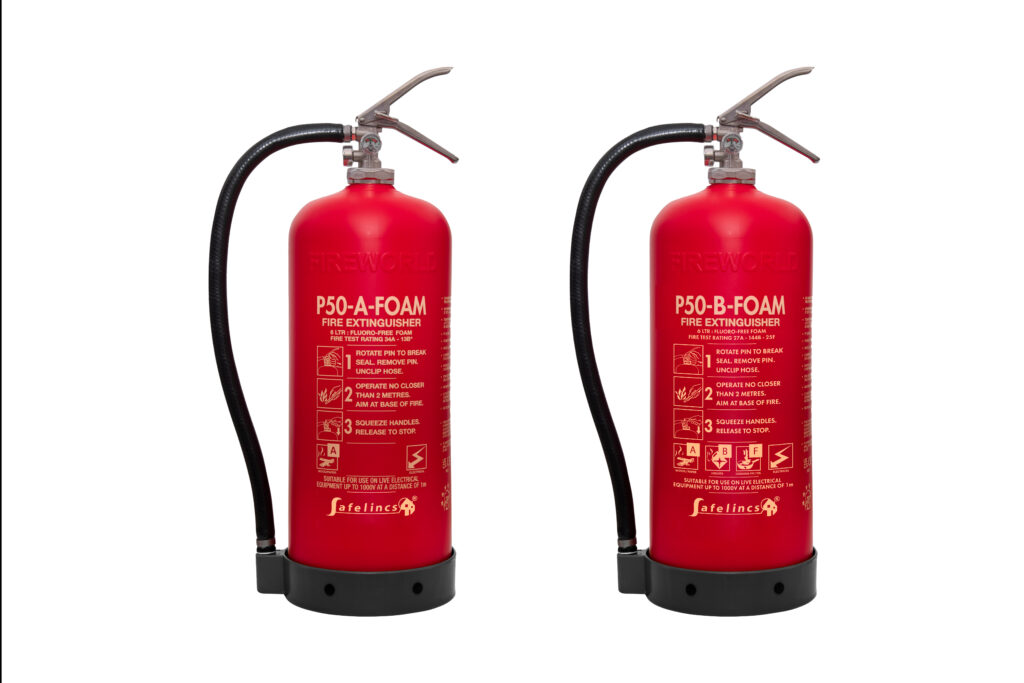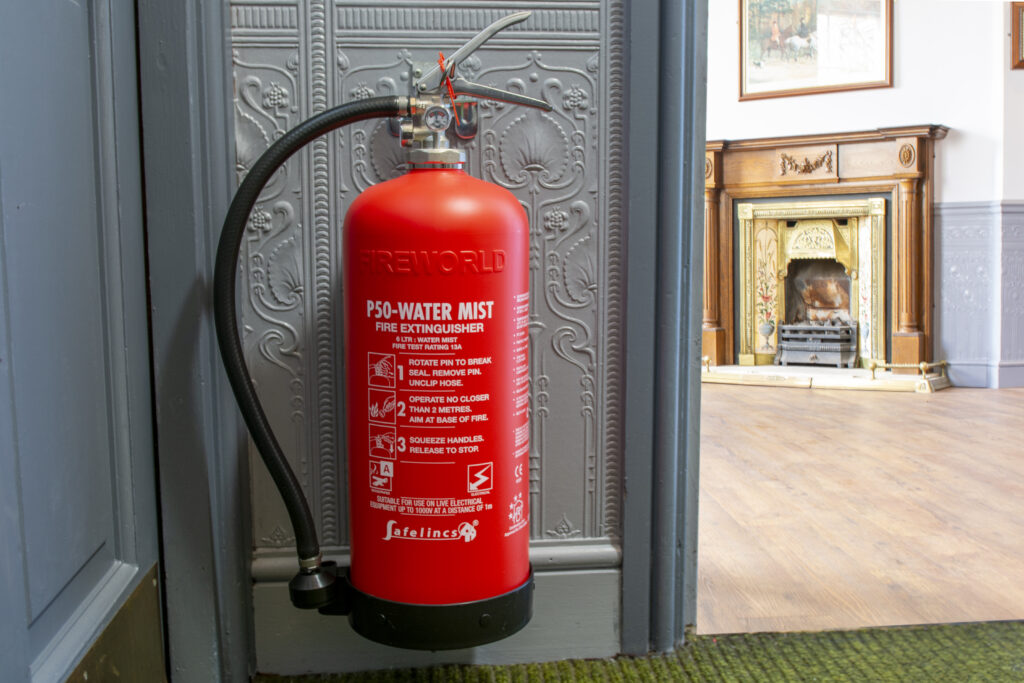What is a powder extinguisher used for?
A
powder extinguisher is used for tackling multiple types of fires. These versatile fire-fighting tools can extinguish Class A fires (involving solid materials like wood and paper), Class B fires (involving flammable liquids), Class C fires (involving gases), and fires involving live electrical equipment up to 1000V at a distance of 1m. When you discharge a powder extinguisher, it forms a thin layer on the burning fuel that absorbs heat and deprives the fire of oxygen, stopping the combustion process. Powder extinguishers are best suited for outdoor environments due to their messy discharge and potential respiratory irritation.
How many types of fire extinguishers are there?
There are several types of fire extinguishers available, each designed to combat specific fire risks. The main types include water, water mist, foam, powder, CO2 and wet chemical extinguishers. Each type works differently and targets specific
fire classes. When selecting which of these types of fire extinguishers to install, you should always base your decision on the fire risk assessment for your premises. The number of types of fire extinguishers you might need depends on the various fire risks present in your environment, with some locations requiring multiple types for comprehensive protection.
How do water fire extinguishers work?
Water fire extinguishers work by cooling the burning material below its ignition temperature. When directed at a Class A fire (involving solid materials like wood, paper and textiles), the water absorbs heat from the fire, reducing the temperature and eventually extinguishing the flames. Traditional water extinguishers are not usually suitable for electrical fires as water conducts electricity, but specialised
water mist extinguishers use de-ionised water that doesn’t conduct electricity, making them safe for use on electrical equipment. Understanding how water fire extinguishers work helps you determine when they’re appropriate to use in an emergency situation.
Which type of fire extinguisher should you use on live electrical equipment?
When dealing with fires involving
live electrical equipment, you should use either a CO2, powder or any water-based extinguisher that has passed a di-electric test in accordance with BS-EN3. Essentially if an extinguisher is marked with the electrical symbol on the front or says it has been di-electrically tested, it is suitable.
What type of fire is a CO2 fire extinguisher used for?
A CO2 fire extinguisher is used for Class B fires involving flammable liquids and fires involving live electrical equipment. The type of fire a CO2 fire extinguisher is most effective against includes those involving electrical equipment, computers and other sensitive electronics where other extinguishing agents might cause damage. CO2 works by displacing oxygen, which starves the fire of one of the elements it needs to continue burning. Unlike powder extinguishers, CO2 extinguishers leave no residue, making them ideal for environments with expensive or sensitive equipment.
What is a dry powder extinguisher used for?
A dry powder extinguisher is used for fighting multiple classes of fire, making it one of the most versatile fire-fighting tools available. When asking what a dry powder extinguisher is used for, the answer includes Class A fires (involving solids like wood and paper), Class B fires (involving flammable liquids), Class C fires (involving gases), and fires involving live electrical equipment up to 1000V from 1m away. Dry powder extinguishers work by releasing a fine powder that forms a barrier between the fuel and oxygen, interrupting the chemical reaction occurring in the fire. They’re particularly valuable in outdoor settings and environments with mixed fire risks, though they should not be used indoors due to cleanup issues and respiratory concerns.
What is a dry chemical powder extinguisher used for?
A dry chemical powder extinguisher is used for combating multiple fire types in a variety of settings. When considering what a dry chemical powder extinguisher is used for, you should know these versatile units can tackle Class A fires (involving solid materials), Class B fires (involving flammable liquids), Class C fires (involving gases), and fires involving electrical equipment up to 1000V at 1m distance. The chemical powder works by interrupting the chemical reaction in the fire while also creating a barrier between the fuel and oxygen. These extinguishers are particularly effective outdoors where their discharge won’t cause visibility issues or respiratory concerns.
What type of fire is a powder extinguisher used for?
A powder extinguisher is used for multiple types of fires, making it highly versatile. When considering what type of fire a powder extinguisher is used for, the answer includes Class A fires (involving solid materials like wood and textiles), Class B fires (involving flammable liquids like petrol and oil), Class C fires (involving gases), and fires involving live electrical equipment up to 1000V when used from a distance of 1m. The powder works by forming a thin layer over the burning material, which absorbs heat and cuts off oxygen supply to the fire. This versatility makes powder extinguishers particularly valuable in environments with mixed fire risks, especially in outdoor settings where their discharge won’t cause visibility or respiratory issues.
What is a powder fire extinguisher not used for?
A powder fire extinguisher is not used for indoor fires in enclosed spaces, despite its versatility for multiple fire classes. Ideally they should not be used in confined areas where people might inhale the powder, which can irritate respiratory and digestive systems. They’re also not recommended for use on delicate equipment due to the difficult cleanup process after discharge. Powder extinguishers are not suitable for Class F fires involving cooking oils and fats. Additionally, they should not be used in situations where visibility is crucial, as the powder discharge can significantly reduce visibility in an enclosed space, potentially hampering evacuation efforts.
What is the ABC powder fire extinguisher used for?
An ABC powder fire extinguisher is used for tackling multiple fire types in a single unit. These versatile extinguishers can combat Class A fires (solid materials like wood, paper and textiles), Class B fires (flammable liquids like petrol and oil), and Class C fires (gases like propane and butane). Additionally, they’re safe for use on fires involving live electrical equipment up to 1000V when used from 1m away. The ABC designation refers to the fire classes the extinguisher can handle, making it a popular choice for locations with varied fire risks. These extinguishers work by releasing a powder that creates a barrier between the fire’s fuel and oxygen while simultaneously interrupting the chemical reaction of combustion.
What is a CO2 fire extinguisher not used for?
A CO2 fire extinguisher is not used for Class A fires involving solid materials like wood, paper and textiles. When asking what a CO2 fire extinguisher is not used for, you should know they have limited effectiveness on deep-seated Class A fires because they don’t provide the cooling effect needed to prevent re-ignition. CO2 extinguishers are also not suitable for Class F fires involving cooking oils and fats. They should not be used in confined spaces without proper ventilation, as they work by displacing oxygen, which can create asphyxiation hazards. Unlike powder, water mist or foam extinguishers that can handle multiple fire classes, CO2 extinguishers are specifically designed for Class B fires and fires involving electrical equipment, making them less versatile in mixed-risk environments.
What does a dry powder fire extinguisher contain?
A dry powder fire extinguisher contains a specialised dust-like powder, typically made of sodium bicarbonate, potassium bicarbonate or monoammonium phosphate, depending on the specific type and intended use. When asking what a dry powder fire extinguisher contains, it’s important to note that this powder is specially formulated to smother fires by forming a thin layer on the burning fuel when discharged. This layer absorbs heat and deprives the fire of oxygen, preventing the continuation of the combustion process. The powder is stored under pressure with nitrogen as the propellant gas. Unlike foam or water extinguishers, dry powder fire extinguishers contain no liquid components, allowing them to be used in freezing conditions outdoors all year round. Powder extinguishers do not contain toxic PFAS chemicals.
What is a foam extinguisher used for?
A foam extinguisher is used for fighting Class A fires (involving solid materials like wood and paper) and Class B fires (involving flammable liquids). When considering what a foam extinguisher is used for, you should know that modern environmentally friendly foam extinguishers, such as P50 A-Foam and B-Foam, work by covering the fire and forming a seal that cuts off the oxygen supply while also providing a cooling effect. Any extinguishers that have been di-electrically tested are also safe for use on live electrical equipment up to 1000V at a distance of 1m. Some foam variants offer the additional benefit of being suitable for Class F fires involving cooking oils.
What are the four types of fire extinguishers?
The four types of fire extinguishers most commonly found in workplaces and public spaces are water, foam, powder and CO2 extinguishers. When asking what are the four types of fire extinguishers, you should understand that each type serves specific purposes: water extinguishers are primarily for Class A fires (solids); foam extinguishers handle Class A and B fires (solids and liquids); powder extinguishers are versatile for Class A, B, C fires and electrical equipment; and CO2 extinguishers target Class B fires and electrical equipment. A fifth type, wet chemical extinguishers, is specifically designed for Class F fires involving cooking oils. Water mist is an additional type of fire extinguisher. Understanding the capabilities of these types of fire extinguishers helps you select the appropriate fire-fighting solution based on your specific fire risks.
What is a wet chemical fire extinguisher used for?
A wet chemical fire extinguisher is used primarily for Class F fires involving cooking oils and fats, making them essential in commercial kitchens and food preparation areas. When deployed, the wet chemical fire extinguisher releases a fine mist that cools the burning oil and undergoes a chemical reaction with the fat to create a soap-like substance that seals the surface and prevents re-ignition. These extinguishers are also effective on Class A fires involving solid materials. They provide a specialised solution for the unique risks posed by high-temperature cooking oils that traditional extinguishers might struggle to combat effectively.
What is the dry powder fire extinguisher class rating?
The dry powder fire extinguisher class rating typically includes Classes A, B and C, making it one of the most versatile extinguishers available. When looking at what the dry powder fire extinguisher class rating covers, you’ll find these extinguishers are suitable for Class A fires (involving solid materials like wood and paper), Class B fires (involving flammable liquids like petrol and oil), and Class C fires (involving gases like propane and butane). Additionally, they’re rated for use on fires involving live electrical equipment up to 1000V from a distance of 1m. This multi-class rating is why powder extinguishers are often chosen for environments with varied fire risks, particularly outdoor settings where their discharge won’t cause visibility or respiratory concerns.




